Effects of Activated Charcoal on Growth, Immunity, Oxidative Stress Markers, and Physiological Responses of Nile Tilapia Exposed to Sub-Lethal Imidacloprid Toxicity
Abstract
:Simple Summary
Abstract
1. Introduction
2. Materials and Methods
2.1. Fish and Rearing Conditions
2.2. Maintenance of Water Quality Parameters
2.3. Experiment I: Feeding Trial
2.3.1. Experimental Diets
2.3.2. Experimental Design
2.3.3. Growth Performance
2.3.4. Blood Sampling and Serum Separation
2.3.5. Hematological Indices
2.3.6. Serum Biochemical Measurements
2.3.7. Antioxidant and Immunological Assays
2.4. Experiment II: Modulation of Sub-Lethal Imidacloprid Toxicity
2.4.1. Experimental Design
2.4.2. Sampling
2.4.3. Determination of Serum Stress Biomarkers
2.4.4. Determination of Imidacloprid (IMID) Residues
2.5. Statistical Analytics
3. Results
3.1. Results of Experiment I
3.1.1. Growth Performance
3.1.2. Hemato-Biochemical Measurements
3.1.3. Antioxidation and Immune Responses
3.2. Results of Experiment II: Responses to Sub-Lethal Imidacloprid (IMID) Toxicity
4. Discussion
4.1. Experiment I-Feeding Trial
4.1.1. Growth Performance
4.1.2. Hemato-Biochemical Indices
4.1.3. Immunity and Antioxidant Biomarkers
4.2. Experiment II-Responses to Sub-Lethal Imidacloprid (IMID) Toxicity
5. Conclusions
Author Contributions
Funding
Institutional Review Board Statement
Informed Consent Statement
Data Availability Statement
Acknowledgments
Conflicts of Interest
References
- Osol, A. Remington’s Pharmaceutical Sciences, 15th ed.; Mack Publishing Co.: Easton, PA, USA, 1975. [Google Scholar]
- Boonanuntanasarn, S.; Khaomek, P.; Pitaksong, T.; Hua, Y. The effects of the supplementation of activated charcoal on the growth, health status and fillet composition-odor of Nile tilapia (Oreochromis niloticus) before harvesting. Aquac. Int. 2014, 22, 1417–1436. [Google Scholar] [CrossRef]
- Galvano, F.; Pietri, A.; Fallico, B.; Bertuzzi, T.; ScirÈ, S.; Galvano, M.; Maggiore, R. Activated Carbons: In Vitro Affinity for Aflatoxin B1 and Relation of Adsorption Ability to Physicochemical Parameters. J. Food Prot. 1996, 59, 545–550. [Google Scholar] [CrossRef]
- Wilson, L.L.; Kurtz, D.A.; Rugh, M.C.; Chase, L.E.; Zieglek, J.H.; Varela-Alvarez, H.; Borger, M.L. Effects of Feeding Activated Carbon on Growth Rate and Pesticide Concentrations in Adipose Tissues of Steers Fed Apple Waste. J. Anim. Sci. 1971, 33, 1361–1364. [Google Scholar] [CrossRef] [PubMed]
- McFarland, A.K.; Chyka, P.A. Selection of Activated Charcoal Products for the Treatment of Poisonings. Ann. Pharmacother. 1993, 27, 358–361. [Google Scholar] [CrossRef]
- Kutlu, H.R.; Ünsal, I.; Görgülü, M. Effects of providing dietary wood (oak) charcoal to broiler chicks and laying hens. Anim. Feed Sci. Technol. 2001, 90, 213–226. [Google Scholar] [CrossRef]
- Samanya, M.; Yamauchi, K.E. Morphological Changes of the Intestinal Villi in Chickens Fed the Dietary Charcoal Powder Including Wood Vinegar Compounds. J. Poult. Sci. 2001, 38, 289–301. [Google Scholar] [CrossRef] [Green Version]
- Mekbungwan, A.; Yamauchi, K.; Sakaida, T. Intestinal Villus Histological Alterations in Piglets fed Dietary Charcoal Powder Including Wood Vinegar Compound Liquid. Anat. Histol. Embryol. 2004, 33, 11–16. [Google Scholar] [CrossRef]
- Pirarat, N.; Boonananthanasarn, S.; Krongpong, L.; Katagiri, T.; Maita, M. Effect of activated charcoal-supplemented diet on growth performance and intestinal morphology of Nile tilapia (Oreochromis niloticus). Thai J. Vet. Med. 2015, 45, 113–119. [Google Scholar]
- Abdel-Tawwab, M.; El-Sayed, G.O.; Shady, S.H. Effect of dietary active charcoal supplementation on growth performance, biochemical and antioxidant responses, and resistance of Nile tilapia, Oreochromis niloticus (L.) to environmental heavy metals exposure. Aquaculture 2017, 479, 17–24. [Google Scholar] [CrossRef]
- Lawal, M.O.; Aderolu, A.Z.; Aarode, O.O.; Seriki, B.M.; Alonge, T.O. Evaluation of soybean meal replacement with sesame seed meal using activated charcoal as an additive in the diet of African catfish juveniles, Clarias gariepinus. Int. J. Aquat. Biol. 2016, 4, 43–50. [Google Scholar]
- Samadaii, S.; Bahrekazemi, M. The effect of diets containing different levels of active charcoal on growth performance, body composition, haematological parameters and possibility of heavy metals detoxification in big sturgeon (Huso huso). Aquac. Res. 2020, 51, 91–101. [Google Scholar] [CrossRef]
- Firdus, F.; Samadi, S.; Muhammadar, A.A.; Sarong, M.A.; Muchlisin, Z.A.; Sari, W.; Batubara, A.S. Gut and intestinal biometrics of the giant trevally, Caranx ignobilis, fed an experimental diet with difference sources of activated charcoal. F1000Research 2020, 9, 444. [Google Scholar] [CrossRef] [PubMed]
- Firdus, F.; Samadi, S.; Muhammadar, A.A.; Sarong, M.A.; Muchlisin, Z.A.; Sari, W.; Mellisa, S.; Satria, S.; Boihaqi, B.; Batubara, A.S. Supplementation of rice husk activated charcoal in feed and its effects on growth and histology of the stomach and intestines from giant trevally, Caranx ignobilis. F1000Research 2020, 9, 1274. [Google Scholar] [CrossRef]
- Thu, M.; Koshio, S.; Ishikawa, M.; Yokoyama, S. Effects of dietary bamboo charcoal on growth parameters, apparent digestibility and ammonia nitrogen excretion of tiger puffer fish, Takifugu rubripes. Aquac. Sci. 2009, 57, 53–60. [Google Scholar]
- Thu, M.; Koshio, S.; Ishikawa, M.; Yokoyama, S. Effects of supplementation of dietary bamboo charcoal on growth performance and body composition of juvenile Japanese flounder, Paralichthys olivaceus. J. World Aquac. Soc. 2010, 41, 255–262. [Google Scholar] [CrossRef]
- Jahan, R.; Quaiyum, M.A.; Jahan, N.; Akhter, T.; Islam, M.S. Dietary added bamboo charcoal can evoke Pangasianodon growth and can reduce ammonia from culture medium. Int. J. Fish. Aquac. 2014, 6, 87–93. [Google Scholar]
- Yoo, J.H.; Ji, S.C.; Jeong, G.S. Effect of dietary charcoal and wood vinegar mixture (CV82) on body composition of Olive flounder Paralichthys alivaceus. J. World Aquac. Soc. 2005, 36, 203–208. [Google Scholar] [CrossRef]
- Michael, F.R.; Saleh, N.E.; Shalaby, S.M.; Sakr, E.M.; Abd-El-Khalek, D.E.; Abd Elmonem, A.I. Effect of different dietary levels of commercial wood charcoal on growth, body composition and environmental loading of red tilapia hybrid. Aquac. Nutr. 2017, 23, 210–216. [Google Scholar] [CrossRef]
- Michael, F.R.; Helal, A.M. Rule of dietary activated wood charcoal on the growth and biochemical composition of gilthead Seabream (Sparus aurata) reared under different stocking densities. Life Sci. J. 2018, 15, 79–86. [Google Scholar]
- Tomizawa, M.; Casida, J.E. Neonicotinoid insecticide toxicology: Mechanisms of selective action. Annu. Rev. Pharmacol. Toxicol. 2005, 45, 247–268. [Google Scholar] [CrossRef] [Green Version]
- Tišler, T.; Jemec, A.; Mozetič, B.; Trebše, P. Hazard identification of imidacloprid to aquatic environment. Chemosphere 2009, 76, 907–914. [Google Scholar] [CrossRef] [PubMed]
- Naiel, M.A.E.; Shehata, A.M.; Negm, S.S.; Abd El-Hack, M.E.; Amer, M.S.; Khafaga, A.F.; Bin-Jumah, M.; Allam, A.A. The new aspects of using some safe feed additives on alleviated imidacloprid toxicity in farmed fish: A review. Rev. Aquac. 2020, 12, 2250–2267. [Google Scholar] [CrossRef]
- Ansoar-Rodríguez, Y.; Christofoletti, C.A.; Marcato, A.C.; Correia, J.E.; Bueno, O.C.; Malaspina, O.; Fontanetti, C.S. Genotoxic potential of the insecticide imidacloprid in a non-target organism (Oreochromis niloticus-Pisces). J. Environ. Prot. 2015, 6, 1360. [Google Scholar] [CrossRef] [Green Version]
- Américo-Pinheiro, J.H.P.; da Cruz, C.; Aguiar, M.M.; Torres, N.H.; Ferreira, L.F.R.; Machado-Neto, J.G. Sublethal effects of Imidacloprid in hematological parameters of Tilapia (Oreochromis niloticus). Water Air Soil Pollut. 2019, 230, 193. [Google Scholar] [CrossRef]
- Ansoar-Rodríguez, Y.; Christofoletti, C.A.; Correia, J.E.; de Souza, R.B.; Moreira-de-Sousa, C.; Marcato, A.C.d.C.; Bueno, O.C.; Malaspina, O.; Silva-Zacarin, E.C.M.; Fontanetti, C.S. Liver alterations in Oreochromis niloticus (Pisces) induced by insecticide imidacloprid: Histopathology and heat shock protein in situ localization. J. Environ. Sci. Health Part B 2016, 51, 881–887. [Google Scholar] [CrossRef] [Green Version]
- Günal, A.Ç.; Erkmen, B.; Paçal, E.; Arslan, P.; Yildirim, Z.; Erkoç, F. Sub-lethal Effects of Imidacloprid on Nile tilapia (Oreochromis niloticus). Water Air Soil Pollut. 2020, 231, 4. [Google Scholar] [CrossRef]
- Naiel, M.A.E.; Ismael, N.E.M.; Abd El-hameed, S.A.A.; Amer, M.S. The antioxidative and immunity roles of chitosan nanoparticle and vitamin C-supplemented diets against imidacloprid toxicity on Oreochromis niloticus. Aquaculture 2020, 523, 735219. [Google Scholar] [CrossRef]
- Crosby, E.B.; Bailey, J.M.; Oliveri, A.N.; Levin, E.D. Neurobehavioral impairments caused by developmental imidacloprid exposure in zebrafish. Neurotox. Teratol. 2015, 49, 81–90. [Google Scholar] [CrossRef] [PubMed] [Green Version]
- Topal, A.; Alak, G.; Ozkaraca, M.; Yeltekin, A.C.; Comaklı, S.; Acıl, G.; Kokturk, M.; Atamanalp, M. Neurotoxic responses in brain tissues of rainbow trout exposed to imidacloprid pesticide: Assessment of 8-hydroxy-2-deoxyguanosine activity, oxidative stress and acetylcholinesterase activity. Chemosphere 2017, 175, 186–191. [Google Scholar] [CrossRef] [PubMed]
- Vieira, C.E.D.; Pérez, M.R.; Acayaba, R.D.A.; Raimundo, C.C.M.; dos Reis Martinez, C.B. DNA damage and oxidative stress induced by imidacloprid exposure in different tissues of the Neotropical fish Prochilodus lineatus. Chemosphere 2018, 195, 125–134. [Google Scholar] [CrossRef]
- Sánchez-Bayo, F.; Goka, K. Unexpected effects of zinc pyrithione and imidacloprid on Japanese medaka fish (Oryzias latipes). Aquat. Toxicol. 2005, 74, 285–293. [Google Scholar] [CrossRef] [PubMed]
- Hong, X.; Zhao, X.; Tian, X.; Li, J.; Zha, J. Changes of hematological and biochemical parameters revealed genotoxicity and immunotoxicity of neonicotinoids on Chinese rare minnows (Gobiocypris rarus). Environ. Pollut. 2018, 233, 862–871. [Google Scholar] [CrossRef] [PubMed]
- Ismael, N.E.M.; Abd El-hameed, S.A.A.; Salama, A.M.; Naiel, M.A.E.; Abdel-Latif, H.M.R. The effects of dietary clinoptilolite and chitosan nanoparticles on growth, body composition, haemato-biochemical parameters, immune responses, and antioxidative status of Nile tilapia exposed to imidacloprid. Environ. Sci. Pollut. Res. 2021. [Google Scholar] [CrossRef] [PubMed]
- Abdelghany, M.F.; El-Sawy, H.B.; Abd El-hameed, S.A.A.; Khames, M.K.; Abdel-Latif, H.M.R.; Naiel, M.A.E. Effects of dietary Nannochloropsis oculata on growth performance, serum biochemical parameters, immune responses, and resistance against Aeromonas veronii challenge in Nile tilapia (Oreochromis niloticus). Fish Shellfish Immunol. 2020, 107, 277–288. [Google Scholar] [CrossRef] [PubMed]
- Abdel-Latif, H.M.R.; Abdel-Tawwab, M.; Khafaga, A.F.; Dawood, M.A.O. Dietary oregano essential oil improved the growth performance via enhancing the intestinal morphometry and hepato-renal functions of common carp (Cyprinus carpio L.) fingerlings. Aquaculture 2020, 526, 735432. [Google Scholar] [CrossRef]
- Mohammadi, G.; Rafiee, G.; El Basuini, M.F.; Abdel-Latif, H.M.R.; Dawood, M.A.O. The growth performance, antioxidant capacity, immunological responses, and the resistance against Aeromonas hydrophila in Nile tilapia (Oreochromis niloticus) fed Pistacia vera hulls derived polysaccharide. Fish Shellfish Immunol. 2020, 106, 36–43. [Google Scholar] [CrossRef]
- Brown, B.A. Routine hematology procedures. In Hematology: Principles and Procedures; Brown, B.A., Ed.; Leo and Fabiger: Philadelphia, PA, USA, 1988; pp. 7–122. [Google Scholar]
- Collier, H.B. Standardization of blood haemoglobin determinations. Can. Med. Assoc. J. 1944, 50, 550–552. [Google Scholar] [PubMed]
- Wintrobe, M.M. Variations in the size and hemoglobin content of erythrocytes in the blood of various vertebrates. Folia Haematol. 1934, 51, 32–49. [Google Scholar]
- Dacie, J.V.; Lewis, S.M. Practical Haematology, 6th ed.; Churchill Livingstone: London, UK, 1984. [Google Scholar]
- Klontz, G. Fish hematology. Techniques in Fish Immunology; Stolen, J.S., Fletcher, T.C., Rowley, A.F., Kelikoff, T.C., Kaatari, S.L., Smith, S.A., Eds.; SOS Publications: Fair Haven, NJ, USA, 1994; Volume 3. [Google Scholar]
- Henry, R. Colorimetric Determination of Total Protein. In Clinical Chemistry; Harper and Row Publ.: New York, NY, USA, 1964. [Google Scholar]
- Wotton, I.D.; Freeman, H. Microanalysis in Medical Biochemistry; Churchill: New York, NY, USA, 1982. [Google Scholar]
- 4Reitman, S.; Frankel, S. A colorimetric method for the determination of serum glutamic oxalacetic and glutamic pyruvic transaminases. Am. J. Clin. Pathol. 1957, 28, 56–63. [Google Scholar] [CrossRef]
- Tietz, N.; Burtis, C.; Duncan, P.; Ervin, K.; Petitclerc, C.; Rinker, A.; Shuey, D.; Zygowicz, E. A reference method for measurement of alkaline phosphatase activity in human serum. Clin. Chem. 1983, 29, 751–761. [Google Scholar] [CrossRef]
- Bartoňková, J.; Hyršl, P.; Vojtek, L. Glucose determination in fish plasma by two different moderate methods. Acta Vet. Brno 2017, 85, 349–353. [Google Scholar] [CrossRef] [Green Version]
- Uchiyama, M.; Mihara, M. Determination of malonaldehyde precursor in tissues by thiobarbituric acid test. Anal. Biochem. 1978, 86, 271–278. [Google Scholar] [CrossRef]
- Anderson, D.; Siwicki, A. Basic Haematology and Serology for Fish Health Programs; Fish Health Section, Asian Fisheries Society: Manila, Phillipines, 1995. [Google Scholar]
- Siwicki, A.; Studnicka, M. The phagocytic ability of neutrophils and serum lysozyme activity in experimentally infected carp, Cyprinus carpio L. J. Fish Biol. 1987, 31, 57–60. [Google Scholar] [CrossRef]
- Ellis, A.E. Lysozyme assays. Tech. Fish Immunol. 1990, 1, 101–103. [Google Scholar]
- Dewangan, G.; Mishra, A.; Mandal, T.K. A simple RP-HPLC method for determining imidacloprid residues in goat tissues. Biomed. Res. 2016, 27, 1. [Google Scholar]
- Dawood, M.A.; Gewaily, M.S.; Soliman, A.A.; Shukry, M.; Amer, A.A.; Younis, E.M.; Abdel-Warith, A.-W.A.; Van Doan, H.; Saad, A.H.; Aboubakr, M. Marine-Derived Chitosan Nanoparticles Improved the Intestinal Histo-Morphometrical Features in Association with the Health and Immune Response of Grey Mullet (Liza ramada). Mar. Drugs 2020, 18, 611. [Google Scholar] [CrossRef] [PubMed]
- Dawood, M.A.O.; Metwally, A.E.-S.; El-Sharawy, M.E.; Ghozlan, A.M.; Abdel-Latif, H.M.R.; Van Doan, H.; Ali, M.A.M. The influences of ferulic acid on the growth performance, haemato-immunological responses, and immune-related genes of Nile tilapia (Oreochromis niloticus) exposed to heat stress. Aquaculture 2020, 525, 735320. [Google Scholar] [CrossRef]
- Abdel-Wahab, M.; Taha, N.; Lebda, M.; Elfeky, M.; Abdel-Latif, H.M.R. Effects of bovine lactoferrin and chitosan nanoparticles on serum biochemical indices, antioxidative enzymes, transcriptomic responses, and resistance of Nile tilapia against Aeromonas hydrophila. Fish Shellfish Immunol. 2021. [Google Scholar] [CrossRef] [PubMed]
- Abdel-Latif, H.; Abou Khashaba, A. Subchronic toxicity of Nile tilapia with different exposure routes to Microcystis aeruginosa: Histopathology, liver functions, and oxidative stress biomarkers. Vet. World 2017, 10, 955. [Google Scholar] [CrossRef] [Green Version]
- El Euony, O.I.; Elblehi, S.S.; Abdel-Latif, H.M.; Abdel-Daim, M.M.; El-Sayed, Y.S. Modulatory role of dietary Thymus vulgaris essential oil and Bacillus subtilis against thiamethoxam-induced hepatorenal damage, oxidative stress, and immunotoxicity in African catfish (Clarias garipenus). Environ. Sci. Pollut. Res. 2020, 27, 23108–23128. [Google Scholar] [CrossRef] [PubMed]
- Khafaga, A.F.; Naiel, M.A.E.; Dawood, M.A.O.; Abdel-Latif, H.M.R. Dietary Origanum vulgare essential oil attenuates cypermethrin-induced biochemical changes, oxidative stress, histopathological alterations, apoptosis, and reduces DNA damage in Common carp (Cyprinus carpio). Aquat. Toxicol. 2020, 228, 105624. [Google Scholar] [CrossRef] [PubMed]
- Alexander, J.B.; Ingram, G.A. Noncellular nonspecific defence mechanisms of fish. Annu. Rev. Fish Dis. 1992, 2, 249–279. [Google Scholar] [CrossRef]
- Secombes, C.J. Isolation of salmonid macrophages and analysis of their killing activity. Tech. Fish Immunol. 1990, 1, 137–154. [Google Scholar]
- Villamil, L.; Tafalla, C.; Figueras, A.; Novoa, B. Evaluation of Immunomodulatory Effects of Lactic Acid Bacteria in Turbot (Scophthalmus maximus). Clin. Diagn. Lab. Immunol. 2002, 9, 1318. [Google Scholar] [CrossRef] [Green Version]
- Awed, E.M.; Sadek, K.M.; Soliman, M.K.; Khalil, R.H.; Younis, E.M.; Abdel-Warith, A.-W.A.; Van Doan, H.; Dawood, M.A.; Abdel-Latif, H.M. Spirulina platensis Alleviated the Oxidative Damage in the Gills, Liver, and Kidney Organs of Nile Tilapia Intoxicated with Sodium Sulphate. Animals 2020, 10, 2423. [Google Scholar] [CrossRef] [PubMed]
- Hoseinifar, S.H.; Yousefi, S.; Van Doan, H.; Ashouri, G.; Gioacchini, G.; Maradonna, F.; Carnevali, O. Oxidative stress and antioxidant defense in fish: The implications of probiotic, prebiotic, and synbiotics. Rev. Fish. Sci. Aquac. 2020, 29, 198–217. [Google Scholar] [CrossRef]
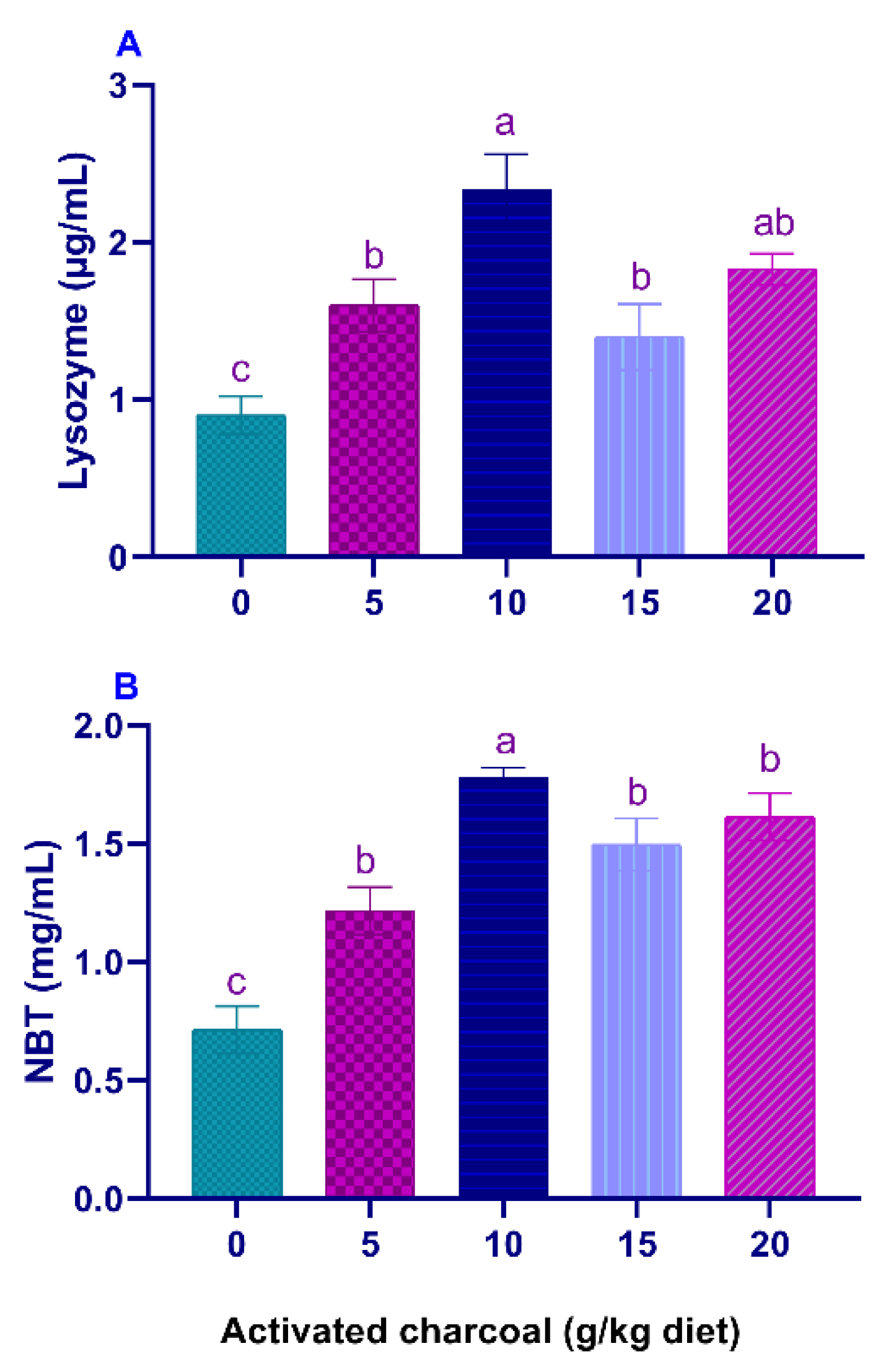
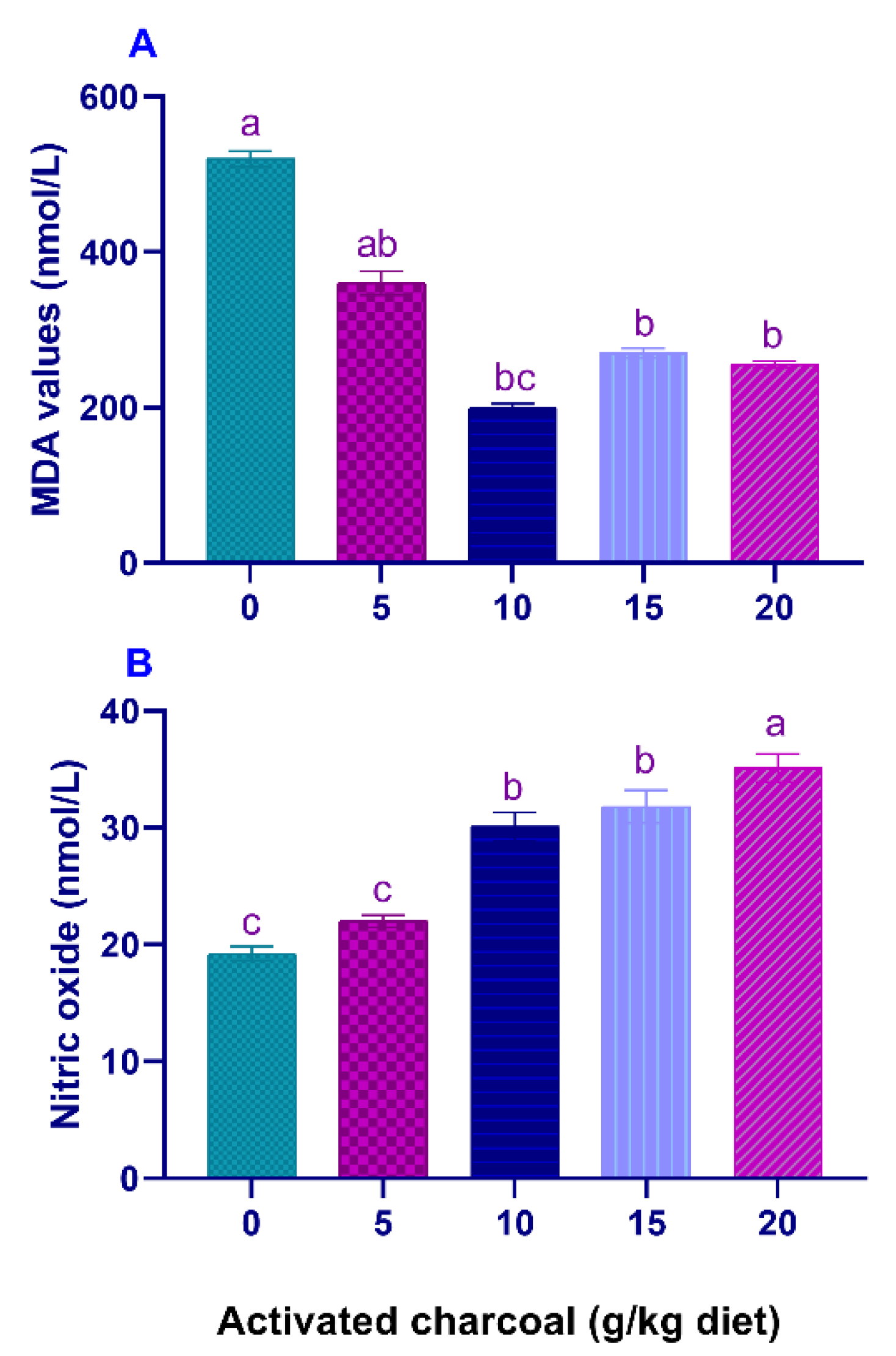
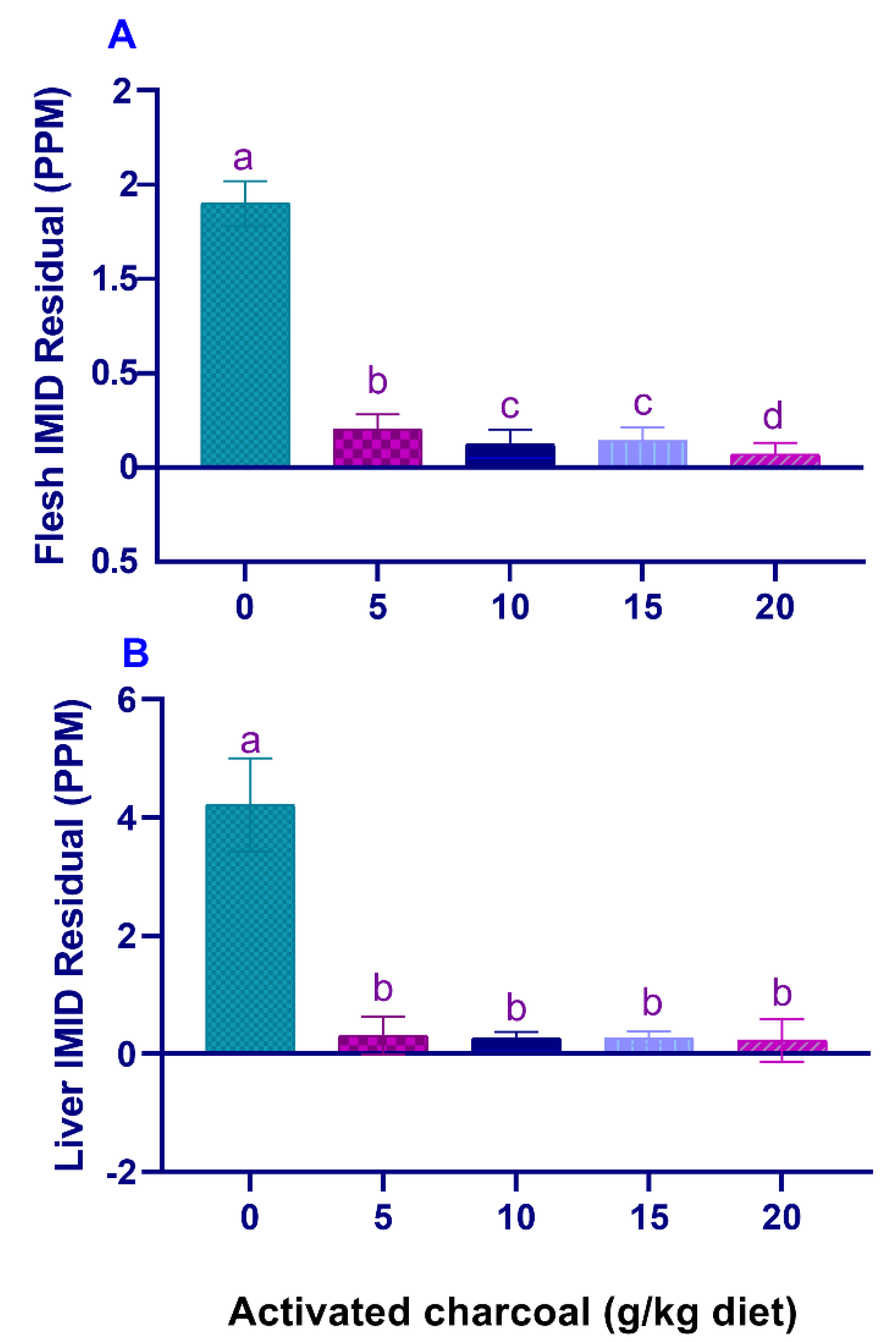
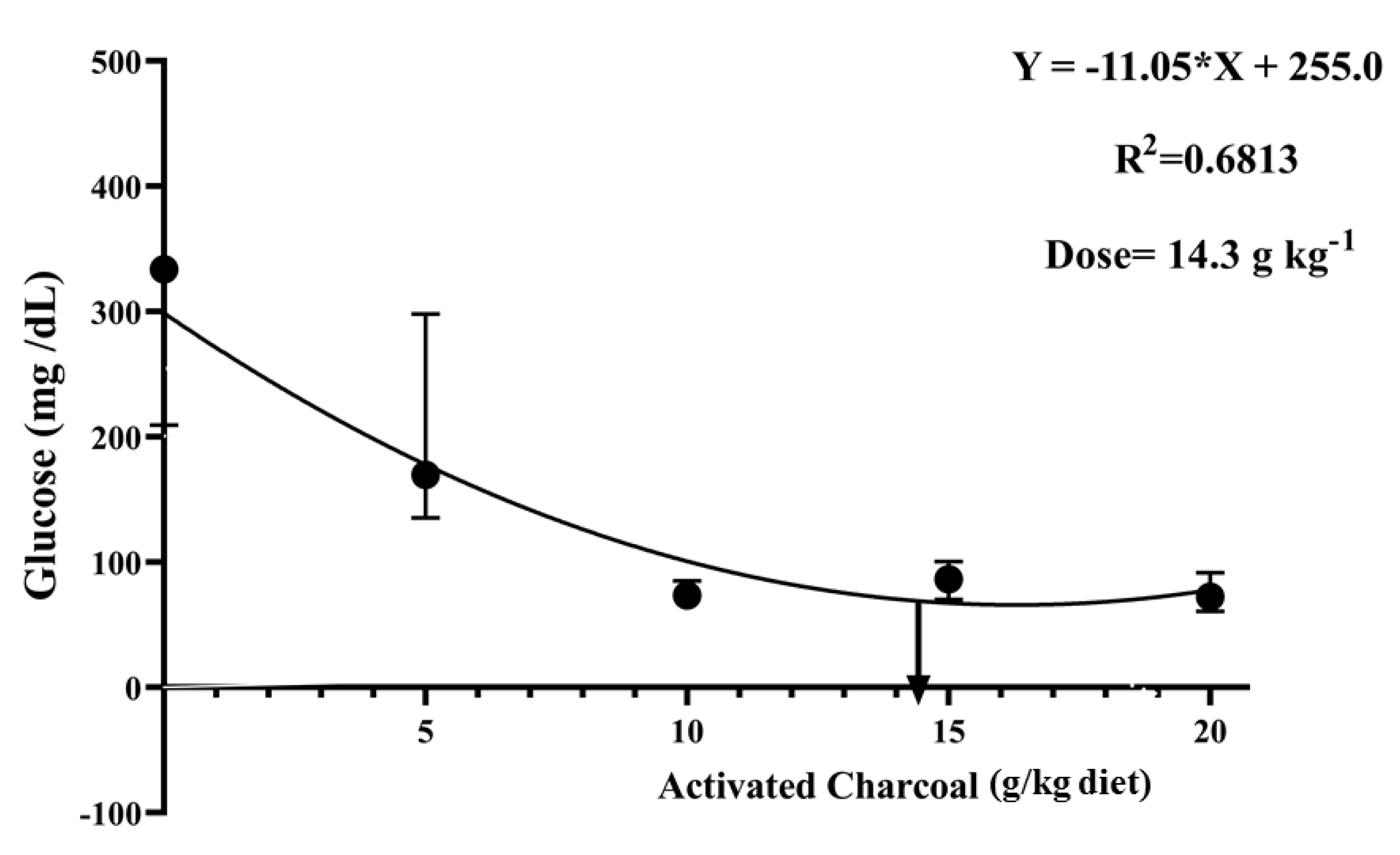
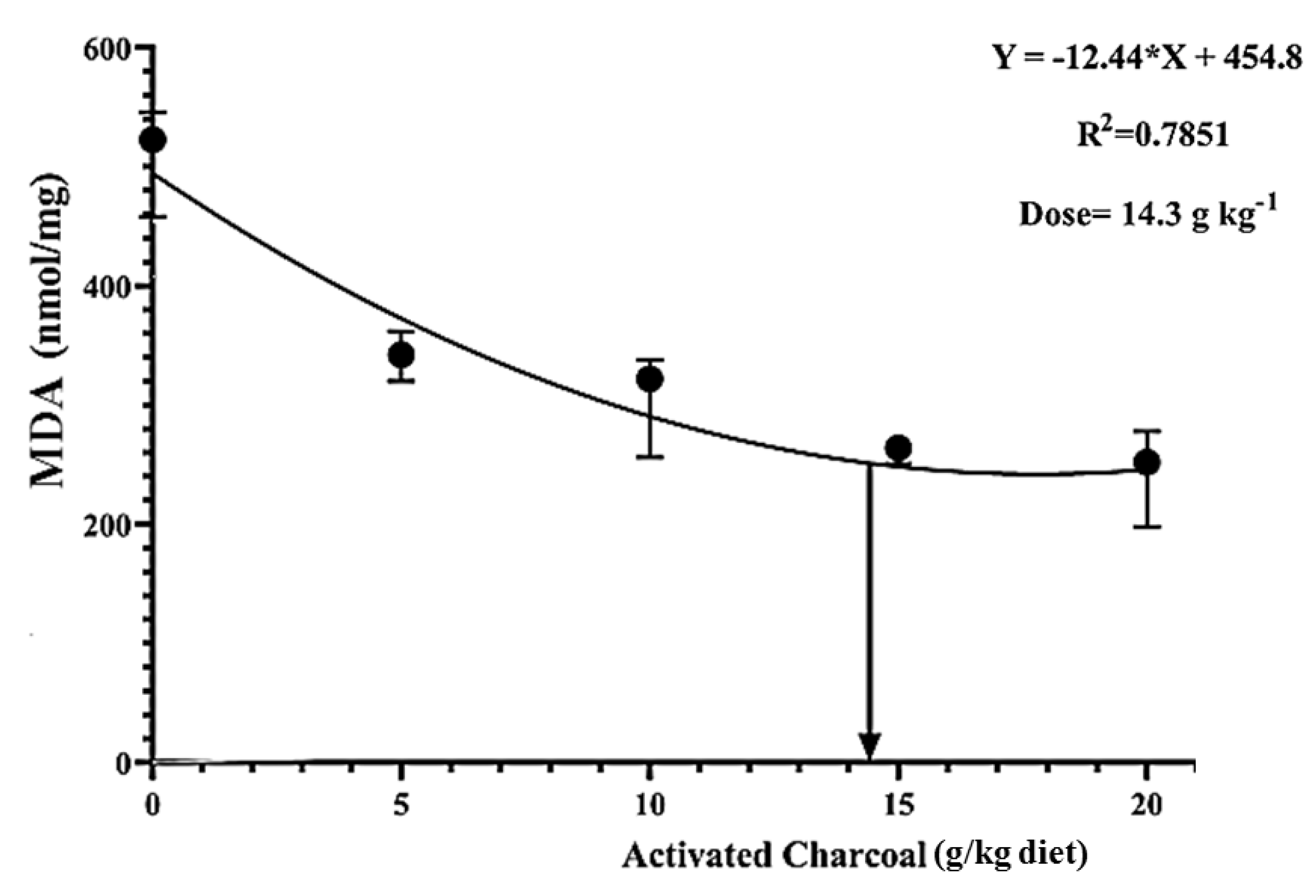
| Feed Ingredients | (%) |
|---|---|
| Fish meal | 15 |
| Yellow corn | 32 |
| Soybean meal (44%) | 20 |
| Corn gluten meal (60%) | 14 |
| Wheat bran | 13 |
| Vegetable oil | 4 |
| Vitamin premix 1 | 1 |
| Mineral premix 2 | 1 |
| Total | 100 |
| Proximate chemical composition (g/kg) as fed basis | |
| Crude protein (CP) (n × 6.25) | 311.5 |
| Crude lipids (CL) | 75.6 |
| Ash | 40.8 |
| Crude fiber (CF) | 53.7 |
| Nitrogen free extract (NFE) 3 | 518.4 |
| Gross energy (MJ per 100 g) 4 | 19.17 |
| Parameters | Experimental Groups | p Value | ||||
|---|---|---|---|---|---|---|
| AC 0 | AC 5 | AC 10 | AC 15 | AC 20 | ||
| IBW (g) | 33.66 ± 0.05 | 33.22 ± 0.09 | 33.17 ± 0.06 | 33.14 ± 0.12 | 33.15 ± 0.32 | 0.356 |
| FBW (g) | 51.05 ± 0.08 c | 55.35 ± 0.33 a | 54.75 ± 0.25 a | 54.44 ± 0.26 a | 53.82 ± 0.61 ab | 0.002 |
| WG (g) | 18.39 ± 0.98 b | 22.13 ± 0.34 a | 21.58 ± 0.24 ab | 21.30 ± 0.76 ab | 20.67 ± 0.63 ab | 0.029 |
| TFI (g) | 30.33 ± 0.13 c | 31.32 ± 0.92 b | 33.19 ± 0.52 a | 33.17 ± 0.02 a | 31.29 ± 0.32 b | <0.001 |
| FER (g/g) | 0.55 ± 0.12 b | 0.66 ± 0.02 ab | 0.71 ± 0.02 a | 0.68 ± 0.10 ab | 0.66 ± 0.05 ab | 0.003 |
| FCR (g/g) | 1.80 ± 0.25 a | 1.50 ± 0.85 bc | 1.41 ± 0.28 d | 1.47 ± 0.37 c | 1.51 ± 0.92 bc | 0.011 |
| SR (%) | 100 | 100 | 100 | 100 | 100 | 0.476 |
| Parameters | Experimental Groups | p Value | ||||
|---|---|---|---|---|---|---|
| AC 0 | AC 5 | AC 10 | AC 15 | AC 20 | ||
| Erythrocyte constituents | ||||||
| RBCs (106 × µL) | 2.22 ± 0.19 | 2.53 ± 0.36 | 2.80 ± 0.44 | 2.61 ± 0.07 | 2.66 ± 0.39 | 0.593 |
| Hb (g/dL) | 8.80 ± 0.57 | 9.38 ± 0.79 | 10.20 ± 0.23 | 9.74 ± 0.95 | 9.67 ± 0.93 | 0.596 |
| PCV (mg/L) | 29.5 ± 1.44 | 32.1 ± 2.57 | 34.5 ± 1.44 | 32.6 ± 0.57 | 33.7 ± 3.33 | 0.568 |
| MCV (fL) | 134.6 ± 4.23 | 129.0 ± 2.33 | 123.4 ± 1.27 | 125.8 ± 1.75 | 128.7 ± 3.43 | 0.585 |
| MCHC (g/dL) | 29.75 ± 0.52 | 29.20 ± 0.21 | 29.63 ± 0.57 | 29.87 ± 0.41 | 28.72 ± 0.80 | 0.328 |
| Leucocyte constituents | ||||||
| WBCs (106 × µL) | 3.40 ± 0.17 | 3.68 ± 0.23 | 3.85 ± 0.87 | 3.64 ± 0.05 | 4.03 ± 0.03 | 0.068 |
| Lymphocyte (106 × µL) | 1.34 ± 0.79 b | 1.71 ± 0.72ab | 1.83 ± 0.11ab | 1.65 ± 0.38ab | 2.01 ± 0.01a | 0.002 |
| Heterophils (106 × µL) | 1.15 ± 0.03 | 1.11 ± 0.31 | 1.20 ± 0.32 | 1.12 ± 0.10 | 1.22 ± 0.33 | 0.129 |
| Eosinophils (%) | 8.53 ± 0.09 | 7.07 ± 0.06 | 6.49 ± 0.29 | 7.69 ± 0.12 | 5.46 ± 0.23 | 0.199 |
| Monocytes (%) | 18.53 ± 0.02 | 16.30 ± 0.27 | 14.99 ± 0.17 | 16.48 ± 0.09 | 14.39 ± 0.43 | 0.588 |
| Parameters | Experimental Groups | p Value | ||||
|---|---|---|---|---|---|---|
| AC 0 | AC 5 | AC 10 | AC 15 | AC 20 | ||
| Blood protein profile | ||||||
| TP (g/dL) | 3.03 ± 0.32 d | 3.41 ± 0.26 c | 5.01 ± 0.36 b | 5.98 ± 0.19 a | 5.74 ± 0.23 ab | <0.001 |
| ALB (g/dL) | 1.03 ± 0.05 d | 1.77 ± 0.81 c | 2.79 ± 0.28 b | 3.93 ± 0.88 a | 3.07 ± 0.66 ab | <0.001 |
| GLO (g/dL) | 1.34 ± 0.55 d | 1.90 ±0.07c | 2.23 ± 0.38 bc | 2.06 ± 0.13 c | 2.67 ± 0.29 a | <0.001 |
| Liver function enzymes | ||||||
| ALP (U/L) | 13.82 ± 0.73 a | 9.98 ± 1.05 b | 7.11 ± 1.16 c | 8.55 ± 0.49 b | 7.28 ± 0.71 c | <0.001 |
| AST (IU/L) | 78.5 ± 1.75 a | 36.5 ± 1.75 b | 28.0 ± 1.69 b | 31.0 ± 1.44 b | 30.5 ± 1.02 b | <0.001 |
| ALT (IU/L) | 100.5 ± 1.56 a | 90.6 ± 1.83 b | 91.0 ± 1.97 b | 66.5 ± 1.89 c | 70.5 ± 1.88 bc | 0.035 |
| Table | Total No. | Dead Fish | SR (%) | MR (%) | RPS (%) |
|---|---|---|---|---|---|
| AC 0 | 32 | 6 | 81.25 | 18.75 | - |
| AC 5 | 32 | 5 | 84.40 | 15.60 | 16.66 |
| AC 10 | 32 | 2 | 93.75 | 6.25 | 66.66 |
| AC 15 | 32 | 2 | 93.75 | 6.25 | 66.66 |
| AC 20 | 32 | 2 | 93.75 | 6.25 | 66.66 |
Publisher’s Note: MDPI stays neutral with regard to jurisdictional claims in published maps and institutional affiliations. |
© 2021 by the authors. Licensee MDPI, Basel, Switzerland. This article is an open access article distributed under the terms and conditions of the Creative Commons Attribution (CC BY) license (https://creativecommons.org/licenses/by/4.0/).
Share and Cite
Abd El-hameed, S.A.A.; Negm, S.S.; Ismael, N.E.M.; Naiel, M.A.E.; Soliman, M.M.; Shukry, M.; Abdel-Latif, H.M.R. Effects of Activated Charcoal on Growth, Immunity, Oxidative Stress Markers, and Physiological Responses of Nile Tilapia Exposed to Sub-Lethal Imidacloprid Toxicity. Animals 2021, 11, 1357. https://doi.org/10.3390/ani11051357
Abd El-hameed SAA, Negm SS, Ismael NEM, Naiel MAE, Soliman MM, Shukry M, Abdel-Latif HMR. Effects of Activated Charcoal on Growth, Immunity, Oxidative Stress Markers, and Physiological Responses of Nile Tilapia Exposed to Sub-Lethal Imidacloprid Toxicity. Animals. 2021; 11(5):1357. https://doi.org/10.3390/ani11051357
Chicago/Turabian StyleAbd El-hameed, Samah A. A., Samar S. Negm, Nahla E. M. Ismael, Mohammed A. E. Naiel, Mohamed Mohamed Soliman, Mustafa Shukry, and Hany M. R. Abdel-Latif. 2021. "Effects of Activated Charcoal on Growth, Immunity, Oxidative Stress Markers, and Physiological Responses of Nile Tilapia Exposed to Sub-Lethal Imidacloprid Toxicity" Animals 11, no. 5: 1357. https://doi.org/10.3390/ani11051357
APA StyleAbd El-hameed, S. A. A., Negm, S. S., Ismael, N. E. M., Naiel, M. A. E., Soliman, M. M., Shukry, M., & Abdel-Latif, H. M. R. (2021). Effects of Activated Charcoal on Growth, Immunity, Oxidative Stress Markers, and Physiological Responses of Nile Tilapia Exposed to Sub-Lethal Imidacloprid Toxicity. Animals, 11(5), 1357. https://doi.org/10.3390/ani11051357










